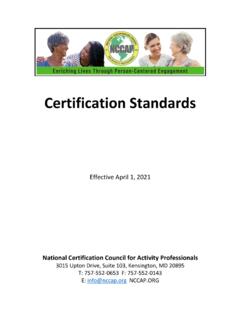Transcription of F-TAG 679 ACTIVITIES. - nccap.org
1 F-TAG 679 activities . (c)(1) The facility must provide, based on the comprehensive assessment and care plan and the preferences of each resident, an ongoing program to support residents in their choice of activities , both facility-sponsored group and individual activities and independent activities , designed to meet the interests of and support the physical, mental, and psychosocial well-being of each resident, encouraging both independence and interaction in the community. INTENT (c). To ensure that facilities implement an ongoing resident centered activities program that incorporates the resident's interests, hobbies and cultural preferences which is integral to maintaining and/or improving a resident's physical, mental, and psychosocial well-being and independence.
2 To create opportunities for each resident to have a meaningful life by supporting his/her domains of wellness (security, autonomy, growth, connectedness, identity, joy and meaning). DEFINITIONS (c). activities refer to any endeavor, other than routine ADLs, in which a resident participates that is intended to enhance her/his sense of well-being and to promote or enhance physical, cognitive, and emotional health. These include, but are not limited to, activities that promote self-esteem, pleasure, comfort, education, creativity, success, and independence.
3 NOTE: ADL-related activities , such as manicures/pedicures, hair styling, and makeovers, may be considered part of the activities program. GUIDANCE (c). Research findings and the observations of positive resident outcomes confirm that activities are an integral component of residents' lives. Residents have indicated that daily life and involvement should be meaningful. activities are meaningful when they reflect a person's interests and lifestyle, are enjoyable to the person, help the person to feel useful, and provide a sense of belonging.
4 Maintaining contact and interaction with the community is an important aspect of a person's well- being and facilitates feelings of connectedness and self- esteem. Involvement in community includes interactions such as assisting the resident to maintain his/her ability to independently shop, attend the community theater, local concerts, library, and participate in community groups. 2018. F-TAG 679 activities . Fax# 757-552-0143. 1. Activity Approaches for Residents with Dementia All residents have a need for engagement in meaningful activities .
5 For residents with dementia, the lack of engaging activities can cause boredom, loneliness and frustration, resulting in distress and agitation. activities must be individualized and customized based on the resident's previous lifestyle (occupation, family, hobbies), preferences and comforts. NOTE: References to non-CMS/HHS sources or sites on the Internet included above or later in this document are provided as a services and do not constitute or imply endorsement of these organizations or their programs by CMS or the Department of Health and Human Services.
6 CMS is not responsible for the content of pages found at these sites. URL addresses were current at the date of this publication. The facility may have identified a resident's pattern of behavioral symptoms and may offer activity interventions, whenever possible, prior to the behavior occurring. Once a behavior escalates, activities may be less effective or may even cause further stress to the resident (some behaviors may be appropriate reactions to feelings of discomfort, pain, or embarrassment, such as aggressive behaviors exhibited by some residents with dementia during bathing16).
7 Examples of activities - related interventions that a facility may provide to try to minimize distressed behavior may include, but are not limited, to the following: For the resident who exhibits unusual amounts of energy or walking without purpose: Providing a space and environmental cues that encourages physical exercise, decreases exit-seeking behavior and reduces extraneous stimulation (such as seating areas spaced along a walking path or garden; a setting in which the resident may manipulate objects;. or a room with a calming atmosphere, for example, using music, light, and rocking chairs).
8 Providing aroma(s)/aromatherapy that is/are pleasing and calming to the resident; and Validating the resident's feelings and words; engaging the resident in conversation about who or what they are seeking; and using one-to-one activities , such as reading to the resident or looking at familiar pictures and photo albums. For the resident who engages in behaviors not conducive with a therapeutic home like environment: Providing a calm, non-rushed environment, with structured, familiar activities such as folding, sorting, and matching; using one-to-one activities or small group activities that comfort the resident, such as their preferred music, walking quietly with the staff, a family member, or a friend; eating a favorite snack; looking at familiar pictures.
9 Engaging in exercise and movement activities ; and Exchanging self-stimulatory activity for a more socially-appropriate activity that uses the hands, if in a public space. For the resident who exhibits behavior that require a less 2018. F-TAG 679 activities . Fax# 757-552-0143. 2. stimulating environment to discontinue behaviors not welcomed by others sharing their social space: Offering activities in which the resident can succeed, that are broken into simple steps, that involve small groups or are one-to-one activities such as using the computer, that are short and repetitive, and that are stopped if the resident becomes overwhelmed (reducing excessive noise such as from the television).
10 Involving in familiar occupation-related activities . (A resident, if they desire, can do paid or volunteer work and the type of work would be included in the resident's plan of care, such as working outside the facility, sorting supplies, delivering resident mail, passing juice and snacks, refer to (e)(8) Resident Right to Work);. Involving in physical activities such as walking, exercise or dancing, games or projects requiring strategy, planning, and concentration, such as model building, and creative programs such as music, art, dance or physically resistive activities , such as kneading clay, hammering, scrubbing, sanding, using a punching bag, using stretch bands, or lifting weights.






